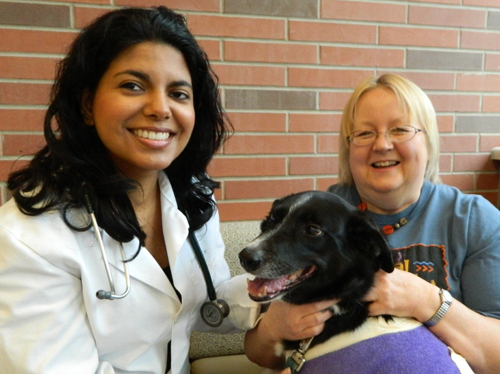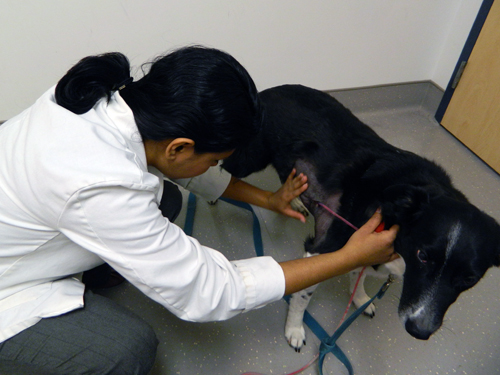Teresa Pitman writes frequently about the Ontario Veterinary College (OVC), but in this story she talks about her personal experience as a pet owner and OVC client.

In her last week as a student veterinarian, Amrita Banerjee made a new friend.
She was doing a three-week rotation at the Hill’s Pet Nutrition Primary Healthcare Centre (PHC) when I brought in my border collie, Maya. Maya had a large lump on her side that had been growing fairly rapidly and was starting to interfere with her movement.
Banerjee says: “When I saw Maya, there was a bit of déjà vu. On my externship last summer, I saw a black lab with a large lipoma almost in the same place.”
My worry, of course, was that the lump might be cancer. Banerjee examined Maya carefully and then brought in staff veterinarian Tiffany Durzi to discuss the findings. They agreed that surgery was indicated.
I was nervous. Maya is nine years old: would surgery be too hard on her? And what if it was cancer?
Banerjee could see I was worried, so she took the time to explain what the surgery would involve and how Maya would be cared for. If it was cancer, there would be time to discuss options. I made an appointment for the operation and went home feeling more confident.
“I really find satisfaction in easing people’s worries when I feel they are nervous,” says Banerjee. “I just think about how I would feel in the client’s shoes. One of the reasons I chose vet school over medical school is that I love caring for animals – and their people! I also chose it because I would get to practice surgery and medicine on a daily basis, which doesn’t happen in the human world!”
It’s easy for Banerjee to put herself in a client’s shoes because she is also a pet owner; she says she wanted a pet from the time she was a toddler. Her first was a budgie, and that opened her eyes to how difficult it can be to find a veterinarian who enjoys caring for birds. “I had to make 15 calls before I found my current vet,” she says. She also has a dog named Titan, who has been part of her life since she was 12.
I dropped Maya off at PHC on a Tuesday morning, and waited with her until she was sedated; I wanted to feel confident my dog would be calm after I left. Banerjee did the actual surgery with help from Durzi, who had joined in because of concerns that the tumour might be attached to muscle. Another student provided the anesthesia. Fortunately, the growth was fairly easy to remove. Afterward, Banerjee stayed with Maya as she recovered from the anesthesia.

I think that’s when their friendship was forged.
Banerjee explains that students are assigned to act as either surgeon or anesthetist in each operation, and are responsible for figuring out medications, dosages and a plan for the surgery. Their plan is reviewed by the veterinarian who oversees the case and supervises the operation. It’s unusual for the veterinarian to actually “scrub up” and join in unless, as in Maya’s case, there are concerns about complications.
The lump, which weighed more than four pounds, wasn’t cancer, just a lipoma. Maya’s recovery has been uneventful.
When I took her back several days later to have her bandages changed, Maya was quite happy to wait in the sunny PHC lobby. One of the staff invited us into an examination room, and we were on our way there when Maya caught sight of Banerjee. Wagging her tail vigorously, Maya half-dragged me across the lobby to greet her friend with enthusiastic licks. My collie obviously remembered the person who had sat with her as she recovered from her operating room adventure.
We had two more visits with Banerjee to have bandages changed and a drain removed. Each time, Maya had a little more energy and was even more excited to see her friend. Others at the clinic might get a sniff and a single tail-wag, but Banerjee got the full-body, jumping-up, so-happy-to-see-you greetings.
As her time at the clinic came to an end, Banerjee confided: “I loved it. I enjoyed being able to practise surgery, do so many appointments and actually be in charge of the care my patients were getting.” She was gone when Maya and I arrived the following Monday; a new rotation of students had arrived.
Maya bounded into the lobby, looking around eagerly. In the examination room, she looked up hopefully each time the door opened and then sat down again when a new student arrived to help the vet. Maya stood patiently while her bandages were changed, and then we left quietly. But she kept looking back.
There’s no looking back for Banerjee. Graduating as a doctor of veterinary medicine this summer, she already has a position with a clinic in Scarborough. “Choosing to be a vet is a big decision, and it’s a gruelling program,” she adds. “But it’s also where I met some of my best friends, and I will be living my childhood dream. I’m so lucky to be able to fulfill that.”